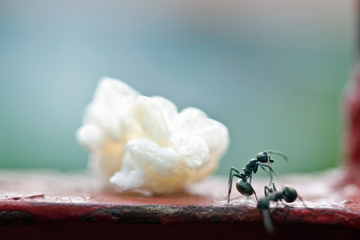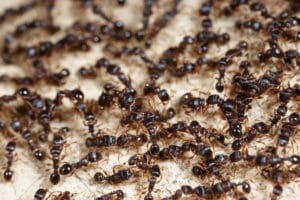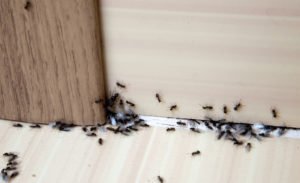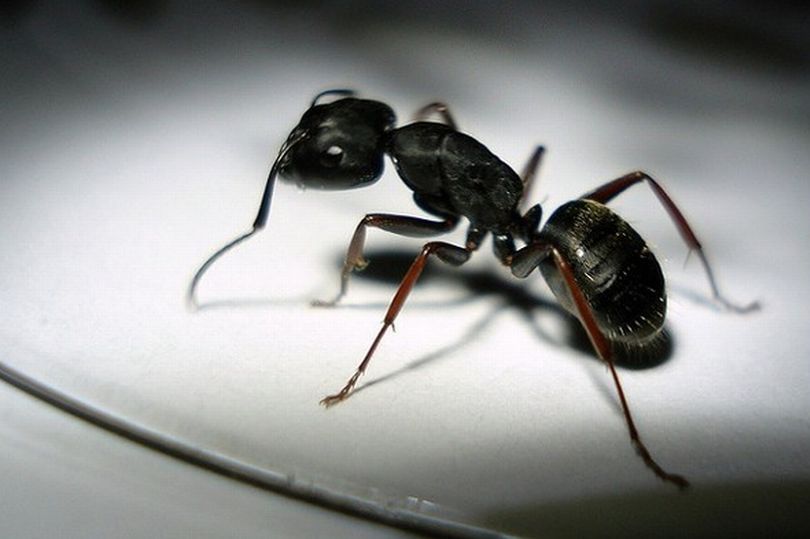How to get rid of ants in your house
With the weather warming up, and many of us meeting family and friends for socially distanced picnics, we’re more likely to begin seeing some rather unwelcome visitors in our homes. You can’t have a picnic without ants, and whether you accidentally transport them back from your picnic, or they find their own way into your home, the tiny little pests can be tricky to get rid of.
They most likely have come into your home in search of some sweet food to take back to their queen and the larvae in their nest. Even if you just see the one, lone ant, it’s best to take action immediately. Ants are very good at communicating and so if one of them finds a source of food, they’ll likely be back with more than a few friends in tow.
Prevention is key
The best way to ensure an ant-free home is to prevent your home from becoming attractive to them in the first place. To do this, make sure floors, kitchen surfaces, tables and chairs are free from any stickiness and spills.
Spills should be immediately cleaned up, and not left to become sticky ant-attraciting messes, while any opened food and drink should ideally be sealed in a container or kept in the fridge. It’s also best to make sure any food crumbs are swept up from under kitchen appliances and units and if you have a pet not even their leftovers are safe from the ants
Arm yourself
While there are plenty of sprays, powders and other options available on the market for getting rid of ants, you can quite easily make your own solution with just soap and water. Fill a spray bottle with the soapy water and put your detective skills to use to track down the ants as they make their trail to and from your home.

Cupboards, Pantries and Ants
If you’re looking for a house guaranteed to be ant-proof, you’ll have to move to Antarctica. It’s one of the few spots on the planet that is too inhospitable for ants. That doesn’t mean you have to share quarters with roaming columns of foraging insects, though. Ants are pretty predictable, and you can keep them out of your cupboards and pantry if you adopt a few ant-busting habits.
Ants send out scouts to look for food. When they find a good source of nourishment, they return to the nest to tell their friends, who then follow the scout ant’s pheromone trail right to your doorstep — or cupboard. That thick column of ants snaking its way from the soda cracker box to your back door started with a single ant scout who — hot on the trail of a dropped cracker crumb — found your stash of cookies, cat food, jelly donuts or cereal and reported his findings to headquarters.
Long before he told his buddies, though, there were a few things you could have done to avoid problems with ants in the first place:
Keep things clean — A little spilled soda or dab of peanut butter may seem harmless, but if an ant stumbles on it and thinks it has potential, that dribble could result in an ant infestation. Clean up spills as soon as they occur. This will help keep ants outdoors where they belong. It will reduce the chance of your countertops and other surfaces becoming a breeding ground for dangerous bacteria, too.
Seal cracks — That mismatched seam at the back of your cupboard might look like a minor structural flaw to you, but to an ant, it’s like a superhighway leading right to the best grocery store in town. Take the time to identify and seal cracks and holes in your cupboards and along your baseboards, windows and doors. Consider making a project of it and also checking your home’s foundation, attic, crawlspace and the areas where water pipes and electrical wires enter the house. Cracks should be sealed and rechecked periodically for suspicious droppings or mud spatters that could mean you have problems with mice, rats, wasps, bees, ants or termites. Use caulk to seal large cracks, and fill tiny cracks with petroleum jelly.
Use bait — Ant baits are an ingenious way to eliminate ant colonies on your property. Here’s how it works: Ants eat the slow-acting poisoned bait and introduce it to the colony. The queen dies, and the nest soon disperses. One nice thing about being proactive about putting down bait traps is that you can eliminate ant troubles long before they become problems.
Use home remedies — If you like the DIY approach to keeping ants out of your cupboards, try sprinkling cinnamon or cayenne pepper on your cabinet shelves. Ants avoid both of these strong-smelling spices. They also steer clear of bay leaf.
Employ deterrents — If you know ants are getting in through a specific location but have been unsuccessful in your efforts to block their access, try putting down diatomaceous earth. These microscopic shells are like razorblades to ants, so they won’t cross them. You can also track ants back to their nest and try soaking them out with a water hose. Just insert the hose into the nest as far as it will go, and turn on the water. A few treatments should flood the nest and convince the ants to move to a new location. Make certain you aren’t dealing with fire ants before you try this, though

How Do I Get Rid of Ants
When you see one or two ants in your home then you probably have many more. Ants never travel alone, they are part of a large colony that is made up of hundreds of thousands of ants. When you see a few ants they are usually out looking for food and they may have found it in your home. Easily accessible items of food are an attractant to ants and will encourage them to build a colony inside, under or around your home
What Is An Ant’s Lifestyle?
Ants live in colonies and have a large social network. Ants are an important part of the ecosystem in their natural environment, as scavengers and predators and they add important nutrients to the soil through recycling. Unfortunately they are not so welcome in gardens and homes across the country and can become problematic. Ant colonies are an active super cell that can grow to an extremely large size in a short amount of time.
An ant colony has its own infrastructure including a queen, the worker ants and the soldier ants. The queen is in control of the colony and lays all of the eggs. The worker ants take care of the eggs as well as the cleaning and maintenance of the nest. They also do all of the foraging for food. It is the job of the soldier ants to protect the colony. Worker ants travel some fairly long distances from the nest when they are foraging. As they travel from the nest they leave chemical secretions along the pathways that they travel. These pheromones are a communication tool and they use it to communicate food sources. Once a food source has been discovered, a large number of worker ants will start to multiply
Adult ants feed on liquids that are transported to the nest internally in other ants. Once worker ants find a food source, they consume it and return to the nest to regurgitate it. This food is shared or stored and any solid food materials collected by workers are fed to the growing and developing larvae. Every different ant species eats a different type of food. Some eat other insects or feed on meat or fat. Some prefer sweet foods like nectar or fruit and others eat just about anything they can find. When you know what kind of ant infestation you are dealing with, one very efficient way of achieving ant control is to remove a known food source
How Do I Know If I Have An Ant Problem?
Ants leave small signs everywhere that they are present. The most notable signs are the small mounds around their entrance holes. You may also notice small piles of material that is gritty and is found around window frames, trim and doors. This material includes wood fragments, fibres, dust and faecal pellets that are produced by ants.

GETTING RID OF ANTS
Okay, we have done all the “normal” things, the non-toxic things, to try to deter them–cinnamon, cayenne, also spraying with a water/rubbing alcohol solution. Everything clean. But they seem to be desperate–in cupboards swarming over a skillet that might have a trace of oil left on it, crawling into a crock full of wooden spoons, etc, next to the stove, in the bathroom sink and bathtub, etc etc.
The ant invasion happens every year about this time and won’t let up until the first rain. We gave up on the non-toxic approach two years ago and pay the pest guy $100 to do his annual spray. We have seen almost no ants since but neighbors and family have them this year in the same numbers as always
I think they have become more persistent and much more numerous as well (they are everywhere). Last year was a nightmare for me – I literally had swaths up and down my bathroom walls including in the shower. And this year, for the first time in 10 years, we got them at the office too. I too gave up on the “natural” approaches – they work for occasional light invasions but not what we are seeing now. Terro seems to work for me. Vinegar as well, to wipe out the pheromone trails they leave for the others. And this year, I too did the annual perimeter spray and am keeping my fingers crossed that it holds up. Might do another spray this weekend for good measure.
I don’t know if this is true but someone years ago said that these are non native ants, something like ARgentinian ants, that are particularly aggressive and probably imported on plants of some sort. Does anyone know if that’s true? They do seem like a different type, but then again, maybe they are just more aggressive b/c of the drought. They do seem much more prolific though. Everywhere you look outside, there are lines of them.
Yes, these are Argentinian Ants. They were actually “accidentally” imported about 100 years ago from the cargo ships that used to deliver lumber here on the Central Coast. (As an aside, Carpinteria got its name because it was a hub of the lumber industry). Anyway, the reason these pesky brown ants are so successful is because they are the ONLY species of ant, that when they encounter a rival nest, they JOIN forces, instead of battling it out, as other species do. Other bad news about them, is they spread diseases in your garden as well. They are like the equivalent of plague rats to our trees and plants, so you really need to keep them under control outside as well. I’ve found for indoors, Terro traps work well, and for spot cleaning and deterrence, Shaklee “Basic H”, which is non-toxic. It comes in a concentrate and is a great all-around cleaning product as well.

How to get rid of ants from your home – tips to stop them in their tracks
With all great things that come with warmer weather, there’s one thing that isn’t so wonderful during the season – ants. We’ve all woken up one morning to be confronted with an infestation of the tiny creatures taking over the kitchen floor
Arm yourself
Grab yourself a spray bottle of soapy water and track down those ants in their trail. Soapy water will kill the ants, whilst destroying their chemical trail – preventing more ants from following their lead into your home.
Defend your home with barriers
Placing barriers around ant access points will stop them from making an entrance – and you’d be surprised at what can act as a barrier. Some items include: a line of chalk, cinnamon, black pepper, baby powder and Vaseline.
Warn them off with a scent
Ants hate strong smells, so using strong scents around your house will stop ants from making themselves a guest in your home again. Spray a white vinegar and water solution or lemon juice on counter tops, clean floors and window sills to stop the ants from crawling all over these surfaces.
Do your chores
If you’ve left food crumbs on the kitchen floor for a timely period, essentially you’re sending out the ants an invitation to a party in your kitchen. Sweeping or vacuuming the kitchen area daily will stop the pests from wanting to enter your home.